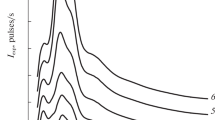Abstract
A radial distribution function (RDF) analysis was performed on amorphous, freeze-dried calcium phosphate prepared under conditions of pH=7.3–8.0 with Ca/P molar ratio of 1.42. Diffracted intensities were obtained by using reflection geometry, copper radiation, and a receiving graphite monochromator. For purposes of analysis, the material was treated as a random binary alloy consisting of calcium and phosphate ions. Major peak positions were found to occur atr=2.55, 3.75 and 6.40 Å and were substantiated by the application of an artificial temperature factor. The first major peak was attributed to a superposition of peaks corresponding to the Ca−O and O−O distances. There is also evidence of a peak at 2.9 Å which suggests the existence of a phosphorus-oxygen network, i.e. condensed phosphates. Densities obtained by this analysis and direct measurement agreed and were substantially less than the accepted value for Ca3(PO4)2. The area under the peak in the RDF corresponding to the unresolved Ca−O and O−O distances yields a coordination number of about 3.
Résumé
Une analyse de fonction de distribution radiaire (RDF) a été réalisée à partir de phosphate de calcium amorphe, après congélation-dessication, préparé à un pH=7.3–8.0 avec un rapport molaire Ca/P de 1.42. Des intensités diffractées sont obtenues en utilisant la géométrie de réflection, les radiations du cuivre et un monochromateur enregistreur de graphite. Pour les besoins de l'analyse, le matériel est traité comme un alliage binaire moyen comportant des ions calcium et phosphate. Les positions de pics majeurs s'observent àr=2.55, 3.75 et 6.40 Å et ressortent par application d'un facteur artificiel de température. Le premier pic important est attribué à une superposition de pics correspondant aux distances Ca−O et O−O. Il existe aussi un pic à 2.9 Å, qui semble indiquer l'existence d'un réseau phosphore-oxygène, à savoir des phosphates condensés. Les densités obtenues par cette analyse concordent avec la mesure directe et sont nettement moindres que la valeur reconnue, pour Ca3(PO4)2. La région située sous le pic dans le RDF, correspondant aux distances non connues Ca−O et O−O, donnent un nombre de coordination d'environ 3.
Zusammenfassung
Eine Funktionsanalyse der radialen Verteilung (FRV) wurde an amorphem, gefriergetrocknetem Calciumphosphat ausgeführt, welches bei pH 7,3–8,0, mit einem molaren Ca/P-Verhältnis von 1,42, hergestellt worden war. Die Beugungsintensitäten wurden mittels Reflexionsgeometrie, Kupferbestrahlung und einem empfangenden Graphitmonochromator erhalten. Zum Zweck der Untersuchung wurde das Material als eine, aus Calcium- und Phosphationen bestehende, randomisierte binäre Mischung behandelt. Die wichtigsten Spitzen wurden beir=2,55; 3,75 und 6,40 Å festgestellt und wurden durch die Verwendung eines künstlichen Temperaturfaktors bestätigt. Die erste wichtige Spitze wurde einem Zusammenfallen von Spitzen zugeschrieben, welche den Ca−O- und O−O-Abständen entsprachen. Bei 2,9 Å wurde ebenfalls eine Spitze festgestellt, welche auf eine Phosphor-Sauerstoff-Verbindung, also auf kondensierte Phosphate, hinweist. Die mit dieser Analyse erhaltenen Dichten entsprachen den direkten Messungen und waren beträchtlich niedriger als dies für Ca3(PO4)2 angenommen wurde. Die Zone unterhalb der Spitze in der FRV, die den unaufgelösten Ca−O-und O−O-Abständen entspricht, ergibt die Koordinationszahl von etwa 3.
Similar content being viewed by others
References
Biscoe, J., Pincus, A. G., Smith, C. S., Warren, B. E.: X-ray study of lime-phosphate and lime-borate glasses. J. Amer. Cer. Soc.24, 116–119 (1941)
Cromer, D. T.: Anomalous dispersion corrections computed, from self-consistent field relativistic Dirac-Slater wave functions. Acta cryst.18, 17 (1965)
Doyle, P. A., Turner, P. S.: Relativistic Hartree-Fock x-ray and electron scattering factors. Acta cryst. A24, 390–397 (1968).
Eanes, E. D., Gillessen, I. H., Posner, A. S.: Mechanism of conversion of non-crystalline calcium phosphate to crystalline hydroxyapatite. In: Crystal growth (ed. H. S. Peiser), p. 373. Oxford: Pergamon Press 1967
Eanes, E. D., Posner, A. S.: Kinetics and mechanism of conversion of non-crystalline calcium phosphate to crystalline hydroxyapatite. Trans. N. Y. Acad. Sci.28, 233–241 (1965)
Gee, A., Dietz, V. R.: Determination of phosphate by differential spectrometry. Analyt. Chem.25, 1320–1324 (1953)
Harper, R. A., Posner, A. S.: Radial distribution study of non-crystalline tri-calcium phosphate. Mat. Res. Bull.5, 129–135 (1970)
Sagel, K.: Tabellen zur Röntgenstrukturanalyse Intensität der Compton-Streuung. In: Electronen-Einheiten, p. 165. Berlin: Springer 1958
Wagner, C. N. J.: A Fortran IV program for the calculation of the radial distribution function of binary alloys. Tech. Rep. No.2, N.S.F.G.P.-3213 (1967)
Wagner, C. N. J.: Structure of amorphous alloy films. J. Vacuum Sci. Tech.6, 650–657 (1969)
Author information
Authors and Affiliations
Rights and permissions
About this article
Cite this article
Fawcett, R.W. A radial distribution function analysis of an amorphous calcium phosphate with calcium to phosphorus molar ratio of 1.42. Calc. Tis Res. 13, 319–325 (1973). https://doi.org/10.1007/BF02015422
Received:
Accepted:
Issue Date:
DOI: https://doi.org/10.1007/BF02015422




